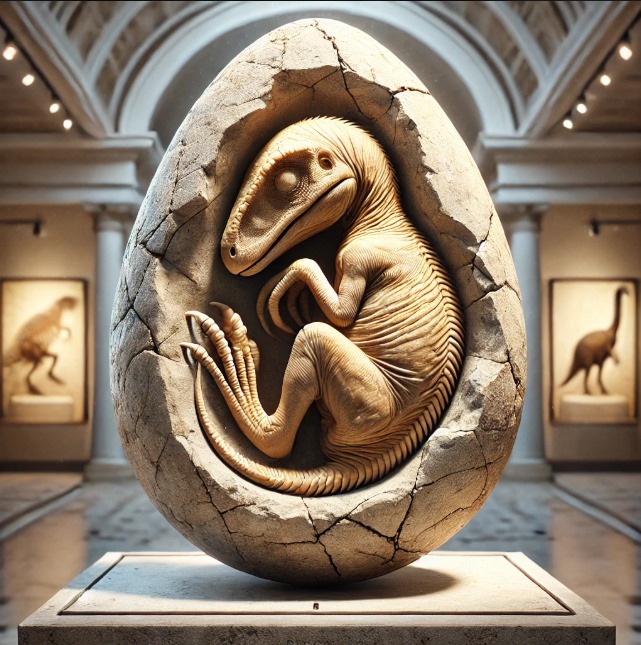Imagine, What if I told you that scientists have discovered a perfectly preserved dinosaur embryo, still curled up inside its egg after 66 million years? It sounds like something straight out of Jurassic Park, but this is real—a groundbreaking fossil that has changed the way we understand dinosaurs, evolution, and even modern birds.
This discovery isn’t just exciting for paleontologists—it’s a window into the past, revealing secrets about how dinosaurs lived, hatched, and evolved into the birds we see today. Let’s dive into the details of “Baby Yingliang,” the most complete dinosaur embryo ever found.
What Did Scientists Find?
In 2021, researchers in China’s Jiangxi province uncovered an incredibly rare fossilized dinosaur embryo inside an egg. What makes this fossil so special?
Major Highlights of Baby Yingliang:
- 66 million-year-old fossil—perfectly preserved inside its egg.
- Most detailed dinosaur embryo ever discovered.
- Shows an unhatched dinosaur in a bird-like position, proving the connection between dinosaurs and birds.
- Belongs to an oviraptorosaur, a beaked, feathered dinosaur that lived in the late Cretaceous period.
- Found at the Yingliang Stone Nature History Museum, hence the name Baby Yingliang.
For the first time, scientists could observe a dinosaur embryo positioned just like a modern bird before hatching. This suggests that birds inherited their hatching behavior directly from dinosaurs.
How Does This Compare to Past Discoveries?
Dinosaur embryos have been found before, but never in this much detail.
- 1990s: Some dinosaur embryos were discovered in Mongolia and Argentina, but they were poorly preserved.
- 2000s: Researchers found fossils showing early dinosaur growth stages, but they lacked complete skeletons.
- 2010s: Advanced CT scanning technology allowed scientists to examine fossils without damaging them.
Baby Yingliang is different because it is the most complete and intact dinosaur embryo ever found. This is like finding a 66-million-year-old time capsule.
How Does This Change What We Know?
This discovery doesn’t just tell us about dinosaurs—it reshapes what we know about evolution and modern birds.
Key Scientific Breakthroughs:
- Proves that birds evolved from dinosaurs—the embryo’s posture is identical to how modern birds prepare to hatch.
- Suggests that dinosaurs, like birds, incubated their eggs instead of burying them in the ground like reptiles.
- Strengthens the evolutionary link between theropod dinosaurs (T. rex, Velociraptors) and modern birds.
Dr. Fion Waisum Ma, one of the lead researchers, stated:
“This dinosaur embryo is one of the best we’ve ever found. It helps confirm that birds inherited many of their traits from dinosaurs.”
Could We Bring Dinosaurs Back?
Whenever we hear about discoveries like this, one question always comes up:
“Can we clone a dinosaur?”
The answer is not yet—but maybe in the future!
The Science Behind Dinosaur Cloning:
- Scientists have not yet found dinosaur DNA in a usable form for cloning.
- Fossils do not contain soft tissues or cells needed for reproduction.
- But with gene-editing technologies like CRISPR, scientists might be able to create creatures with dinosaur-like traits.
In fact, some researchers are already trying to reverse-engineer birds to recreate dinosaur-like species.
So while we might not see real-life Jurassic Park anytime soon, this discovery takes us one step closer to understanding these prehistoric giants.
What This Means for the Future
This discovery isn’t just about dinosaurs—it’s about how life evolves.
Why This Discovery Matters:
- Helps us understand how dinosaurs hatched and cared for their young.
- Strengthens the evolutionary link between dinosaurs and birds.
Opens new research possibilities about how ancient species adapted over time.
Books on Dinosaur Embryos & Fossilized Eggs
we are guessing that you are interested in learning more about dinosour embryos, fossilized eggs and prehistoric discoveries, or Preserved Dinosaur Embryo. Here are some books that you might find interesting.
- Dinosaur Eggs Discovered: Unscrambling the Clues” – Lowell Dingus, Luis M. Chiappe, and Rodolfo Coria
- “The Great Dinosaur Egg Hunt” – John R. Horner & James Gorman
- “Hatching the Past: The Great Dinosaur Egg Hunt” – Charles R. Knight
Final Thoughts
If a perfectly preserved dinosaur embryo can survive for 66 million years, imagine what else is still buried beneath the Earth—just waiting to be discovered.
What do you think? Should we try to bring dinosaurs back, or should we let them stay in the past? Let us know your thoughts!
If you loved this article, share it with fellow science lovers and dinosaur enthusiasts.


